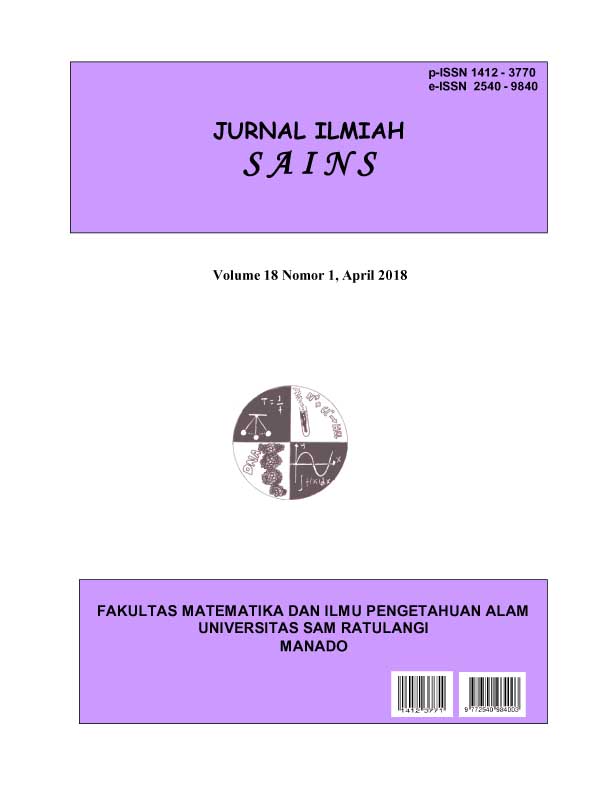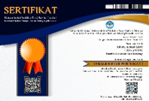PREPARASI DAN KARAKTERISASI NANOSILIKA DARI JERAMI PADI
DOI:
https://doi.org/10.35799/jis.18.1.2018.19089Abstract
PREPARASI DAN KARAKTERISASI NANOSILIKA DARI JERAMI PADI
ABSTRAKPenelitian ini dilakukan untuk mengetahui karakteristik silika yang diekstraksi dari jerami padi yang diperoleh dari wilayah usaha tani padi Pekalongan. Silika diperoleh dengan metode sol-gel, yang melibatkan ekstraksi silika dengan larutan alkali dan gelasi silika menggunakan larutan asam. Ditemukan bahwa hasil tertinggi diperoleh dari ekstraksi menggunakan larutan KOH 5% dengan waktu ekstraksi 60 menit, dan pH gelasi 7.0. Persiapan berhasil diproduksi dengan memanaskan jerami padi pada suhu 10 °C/menit dan menahannya pada suhu 500°C untuk memudahkan penguraian dan pengadopsian bahan organik sambil menghindari pengapian otomatis. Komposisi kimia SiO2 diperkuat oleh EDS dan FTIR dan sifat amorf oleh XRD.Serbuk nanosilika dengan ukuran pori rata – rata 45,3869 nm dan memiliki permukaan spesifik (94,761 m2/g).
Kata kunci: Jerami padi; Nanopartikel silika, Sol gel
Â
PREPAPARATION AND CHARACTERIZATION NANOSILICA
FROM RICE STAW
ABSTRACT
This study was carried out to investigate the characteristics of silica extracted from rice straw obtained from rice farming region of Pekalongan. The silica was obtained using sol-gel method, which involves extraction of silica using alkalis solution and gelation of the silica using acid solution. It was found that the highest yield was obtained from the extraction using 5% KOH solution with the extraction time of 60 minutes, and gelation pH of 7.0. Preparation was successfully produced by heating rice straw at 10 °C/min and holding at 500°C to facilitate decomposition and gasiï¬cation of the organics while avoiding auto-ignition. The SiO2 chemical composition was conï¬rmed by EDS and FTIR and the amorphous nature by XRD. Nanosilica powders with a 45,3869 nm average pore size and have speciï¬c surface (94,761 m2/g).
Keywords: Rice straw; Silica nanoparticles, Sol gel
References
Agbagla-Dohnani A, P.Nozière, G. Clément, M. Doreau. 2001. Chemical and morphological composition of 15 varieties of european rice straw. Anim Feed Sci Technol 94: 15-27.
Arryanto, Y.S.A., M.F. Rosyid, A. Rhaman, P. Artsanti. 2007. Iptek Nano di Indonesia. Deputi Bidang Perkembangan Riptek Kementerian Negara Ristek dan Teknologi. 206 Hal. ISBN 979-24-0571-2.
Daifullah, A.A.M., B.S. Girgis, and H.M.H Gad. 2003. Utilization of Agro-Residues (Rice Husk) in Small Waste Water Treatment Plans. Material Letters 57:1723–1731.
Dorigato A., M. Sebastiani and A. Pegoretti. 2012. Effect of silica nanoparticle on the mechanical performances of poly (lactic acid). Journal of Polymers and Environment 20: 713-725.
Guo Y., M. Wang, H. Zhang, G. Liu, L. Zhang and X. Qu. 2008. The surface modification of nanosilica, preparation of nanosilica/acrylic core-shell latex, and is application in toughening PVC matrix. Journal of Applied Polymer Science 107: 2671-2680.
Hessien M. M., M.M. Rashad, R.R. Zaky, . E.A. Abdel-Aal and K.A. El-Barawy. 2009. Controlling the synthesis conditions for silica nanosphere from semiburned Rice straw. Materials Science and Engineering B, 162: 14-21.
Jal P.K., M. Sudarshan, A. Saha, S. Patel and B.K. Mishra. 2004. Synthesis and characterization of nanosilica prepared by precipitation method. Colloids and Surfaces A: Physicochemical and Engineering Aspects 240: 173-178.
Kalapathy U., A. Proctor and J. Shultz. 2000. A simple method for production of puresilica from rice hull ash. Bioresource Technology 73: 257-262.
Kamath,S.R and A. Proctor. 1998. Silica gel from rice hull ash: preparation and characterization. Cereal Chemistry 75, 484–487.
Kharisov B.I., O.V. Kharissova and M. Jose-Yacaman. 2010. Nanostructures with animal like shapes. Industrial and Engineering Chemistry Research 49: 8289-8309.
Lai C Y. 2013. Mesoporous nanomaterials applications in catalysis. Journal of Thermodynamics & Catalysis 5:1–3. DOI: 10.4172/2157-7544.1000e124.
Lin, J., J.A. Siddiqui and M. Ottenbrite. 2001. Surface Modification of Inorganic Oxide Particles with Silane Coupling Agent and Organic Dyes. Polymer Advance Technology, 12:285–292.
Liou,T.H. 2004. Preparation and characterization of nano-structured silica from rice husk, Materials Science and Engineering a-Structural Materials Properties Microstructure and Processing 364, 313–323.
Liu, Y., Y. Guo, D. Zhu, W. Gao, Z. Wang. 2011. A sustainable route for the preparation of activated carbon and sil ca from rice husk ash. Journal of Hazardous Materials 186, 1314–1319.
Lu, P., Y.L. Hsieh. 2012. Highly pure amorphous silica nano-disks from rice straw. Powder Technology. 225 149-155.
Mourhly, A., M. Khachani, A.E. Hamidi, M. Kacimi, M. Halim and S. Arsalane. 2015. The Synthesis and Characterization of Low-Cost Mesoporous Silica SiO2 from local Pumice Rock. Nanomaterials and Nanotechnology (DOI: 10.5772/62033).
Rafiee, E., S. Shahebrahimi, M. Feyzi, M. Shaterzadeh. 2012. Int. Nano Letters 21.
Ranjbar, M and G.A. Shams. 2009. Using of Nanotechnology. Journal of Environment Green, 3: 29-34.
Santos, M.B., G.A. Nader, P.H. Robinson, D. Kiran, U. Krishnamoorthy and M.J. Gomes. 2010. Impact of simulated field drying on in vitro gas production and voluntary dry matter intake of rice straw. Anim Feed Sci Technol 159: 96-104.
Silva, J.A. 1981. Possible mechanism for crop response to silicate application. Proc.nt.Sym.Soi; Fertilities Evaluation, New Delhi, 1:805:814.
Singh D., R. Kumar, A. Kumar and K.N. Rai. 2008. Synthesis and characteri-zation of rice husk silica, silica-carbon composite and H3PO4 activated silica. Ceramica 54: 203-212.
Sitorus. 2004. Pengujian Pupuk Phonska Pada Tanaman Jagung Hibrida Varietas Pioner Pada Inteceptisol Dari Cibugel, Sumedang. Skripsi. Dipublikasikan. Program Studi Ilmu Tanah (S1). Departemen Tanah. Fakultas Pertanian. Institut Pertanian Bogor.
Stone V., B. Nowack, A. Baun, N.V.D. Brink, F.V.D. Kammer, M. Dusinska, R. Handy, S. Hankin, M. Hassellov, E. Joner and T.F. Fernandes. 2010. Nanomaterials for environmental studies: Classification, reference material issues, and strategies for physico-chemical characterization. Science of the Total Environment 408: 1745-1754.
Sudibyo, B.S. 2008. Pengaruh Pemberian Si terhadap Serapan Si dan hasil Jagung (Zea mays., L) pada Andisol. Skripsi. Srjana S1 Fakultas Pertanian UGM Yogyakarta.
Sun Q., E.G. Vrieling, R.A. Van-Santen and N.A.J.M Sommerdijk. 2004. Current Opinion in Solid State and Material Science 8: 111-120.
Suwardjono. 2001. Pengaruh Beberapa Jenis Pupuk Kandang terhadap Pertumbuhan dan Produksi Kacang Tanah. Jurnal Matematika, Sain dan Teknologi. 2 (2): 11-18.
Wu,Y.Q., S.Y. Wu, Y. Li and j.s. Gao. 2009. Physico-chemical characteristics and mineral-transformation behavior of ashes from crop straw. Energy & Fuels 23 5144–5150.
Yang J, E. Wang. 2006. Reaction of water on silica surfaces. Current Opinion in Solid State and Materials Science 10:33–39. DOI: 10.1016/j.cossms. 2006.02.001.
Zaky R. R., M.M. Hessien, A.A. El-Midany, M.H. Khedr, E.A. Abdel-Aal and K.A ElBarawy. 2008. Preparation of silica nanoparticles from semi-burned rice straw ash. Powder Technology 185: 31-35.







